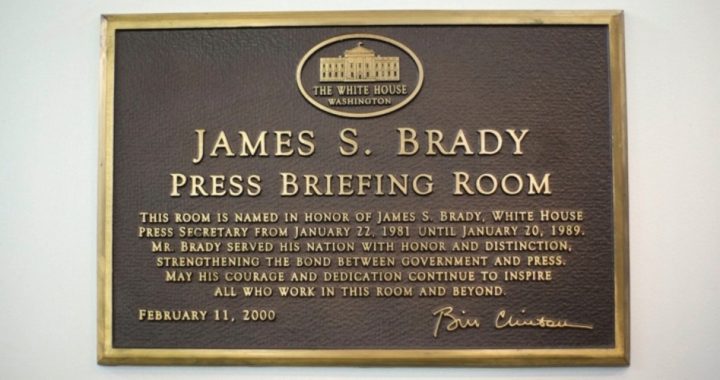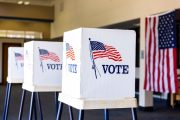
On Monday the national media and the president noted the passing at age 73 of James Brady, the man who served briefly as President Reagan’s press secretary before being grievously wounded in an assassination attempt on the president nearly 33 years ago.
The New York Times called Brady “a symbol of the fight for gun control,” while President Obama declared, “An untold number of people are alive today who otherwise wouldn’t be, thanks to Jim.” Dan Gross, president of the Brady Campaign, agreed, saying that the law named to honor the former press secretary, the Brady Handgun Violence Prevention Act, has blocked about two million sales of firearms “to criminals, domestic abusers and other dangerous people.” Echoing the president, Gross added that there are “few Americans in history who are as directly responsible for saving as many lives as Jim.”
On Monday, March 30, 1981, John Hinckley, Jr., attempted to assassinate President Ronald Reagan as he was leaving a speaking engagement at the Washington Hilton Hotel in Washington, D.C. Firing six shots, Hinckley hit four individuals including the president, a police officer, a Secret Service agent, and James Brady. Brady’s near-fatal head wound left him partially paralyzed for the rest of his life, although he eventually regained most of his physical abilities and much of his mental acuity.
Brady’s wife Sarah didn’t get involved in the gun control movement until years after the shooting, joining the board of Handgun Control, Inc. (HCI) in 1985 and becoming its chair in 1989. In 1991 she also became chair of the Center to Prevent Handgun Violence. In 2001, the two groups were renamed the Brady Campaign to Prevent Gun Violence and the Brady Center to Prevent Gun Violence, respectively, in honor of the Bradys.
The purpose of HCI was made abundantly clear in July, 1976, when Pete Shields, a former Republican Party marketing director and then chairman of the National Council to Control Handguns (renamed HCI in 1980), laid out its goals:
The first problem is to slow down the increasing number of handguns being produced and sold in this country. The second is to get handguns registered.
And the final problem is to make the possession of all handguns and all handgun ammunition — except for the military, policemen, licensed security guards, licensed sporting clubs and licensed gun collectors — totally illegal.
He thought, following the gains HCI made after the murder of John Lennon in December 1980, that it would take between seven and 10 years to reach his goal of “total control of handguns in the United States.” In reality, it is taking a little longer. When the Brady bill was finally signed into law in November, 1993, Shields recognized reality, remarking humorously, “It takes two years to make Minute Rice.”
That bill was introduced in the House of Representatives by Rep. Charles Schumer (D-N.Y.) in February 1993, and following much debate was passed the following November by the House, 238-189. Ten days later the bill passed the Senate, and was signed into law by President Clinton on November 30, 1993. The legislation instituted federal background checks on firearm purchasers, who could be turned down for a number of reasons, including conviction of a crime in any court punishable by imprisonment for a term of more than one year. Unlawful users of controlled substances were also ineligible, along with “mental defectives” or those committed to a mental institution. Transfers between private sellers are not subject to the Brady bill.
As Russell Berman, writing for the Atlantic Wire, expressed it:
The signing of the Brady Bill proved to be the high-water mark for federal gun control efforts in the last 20 years. The Democrats’ blowout loss in the congressional elections of 1994 was blamed in part on a backlash against the new law by supporters of gun rights, and aggressive lobbying by the National Rifle Association has effectively blocked most new federal gun control laws in the two decades since.
In addition, recent Supreme Court decisions have supported the Second Amendment while an increasing number of states have implemented concealed carry laws. Americans now own an estimated 270 million firearms, making them the best-armed civilian population in the world. According to the Small Arms Survey, there are 97 guns per 100 residents in the United States, while a poll by Economist/YouGov shows that four out of 10 households have at least one gun present.
The result has been a predictable and steady decline in the rate of violent gun-related crime.
The irony is remarkable: The stated intent of the gun-controllers is to reduce crime, but their obvious heavy-handed attempts to accomplish this through draconian laws have failed. Instead, the push-back generated by the Brady Bill that has caused Americans to become more aware of their precious rights guaranteed in the Bill of Rights, especially and particularly by the Second Amendment. This has led them not only to become better informed citizens about those rights, but to generate political pressure in the states to allow them to exercise those rights more freely. As the number of gun owners increases, crime is dropping.
That is the true legacy of James Brady and the Brady Bill.
Photo of plaque in the White House dedicated to James Brady: AP Images
A graduate of Cornell University and a former investment advisor, Bob is a regular contributor to The New American magazine and blogs frequently at www.LightFromTheRight.com, primarily on economics and politics.



